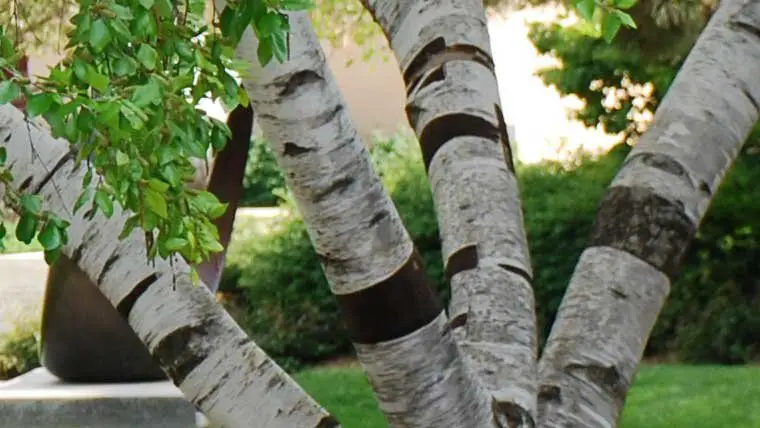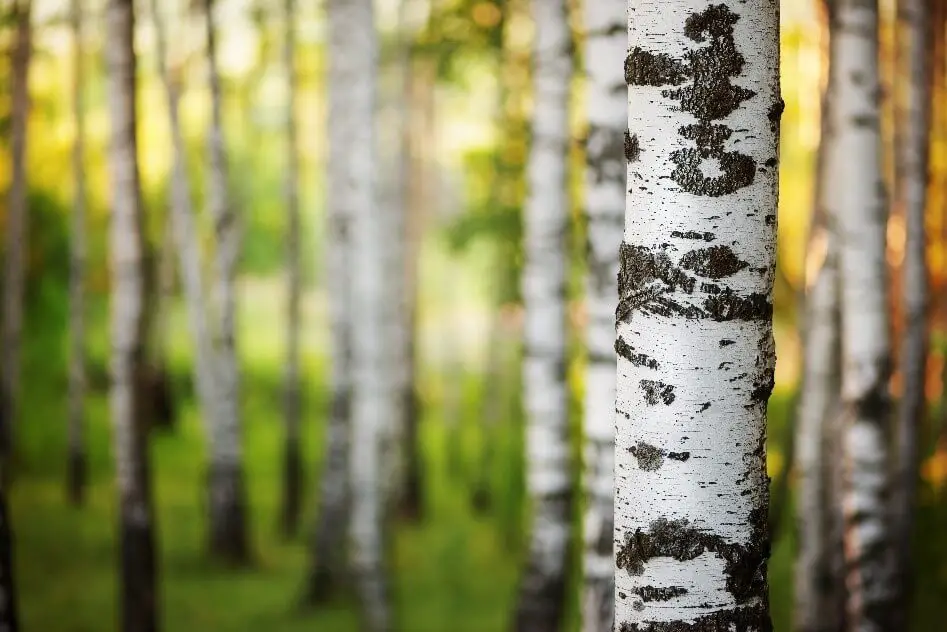Last Updated on August 15, 2023 By Emma W. Thomas
Birch trees display black streaks on their trunks due to a fungal infection called birch canker, caused by the pathogen Pseudomonas syringae. This disease damages the tree’s vascular system, leading to characteristic dark streaks. Prompt management and pruning can help mitigate its impact.
Why Do Birch Trees Have Black Streaks on Their Trunk?
Birch trees, highly celebrated for their distinctive beauty, often leave many wondering about the presence of black streaks on their trunk. These black streaks, which stand out against the birch tree’s general white bark, aren’t random or meaningless. They actually have a variety of reasons behind their presence which may vary from tree to tree. Here are some reasons why birch trees have black streaks on their trunks:
1. Natural Bark Coloration
One primary reason is simply their natural coloration. The surface of a birch tree’s trunk may feature a mixture of colors – ranging from white to gray, silver, or black. These color variations are normal and often create intricate patterns that add to the birch tree’s aesthetic appeal.
2. Fungal Disease
The presence of black streaks on a birch tree’s trunk may sometimes indicate a fungal disease, such as Birch Canker. The fungus invades the tree through its bark and develops dark patches or streaks under the outer layer of the bark. When these cankers rupture, they often release a sticky sap that hardens into a black residue.
| Diseases | Signs & Effects |
|---|---|
| Birch Canker | Black streaks, cankers, sticky sap |
3. Insect Infestation
Certain insects, like the birch borer, may infest a birch tree and cause dark streaks to appear. This results from the scars left behind by larvae chewing through the tree’s inner bark. Like fungus infections, these infestations can also cause sap to seep from the affected areas, leading to the formation of black streaks.
4. Lichen Growth
Occasionally, patches of black on a birch tree’s trunk may be due to lichen growth. While these organisms don’t harm the tree and are not indicative of disease, they do tend to form blackish or dark patches against the light-colored bark.
5. Physical Damage
Physical damage to the birch tree, perhaps caused by high winds or animals, can lead to dark streaks forming on the tree trunk. As the tree attempts to heal itself, sap may seep out and dry on the bark’s surface, causing dark streaks over time.
How do you know if a birch tree is dying?
Birch trees die either from borer beetle infestation or extremely hot weather. The surest sign of a dying birch tree is insect exit holes on the tree’s bark or wilting at the crown. Once you notice such signs, it is advisable to cut down the birch tree to prevent further damage.
Dying birch trees pose the risk of infecting nearby trees with larvae, and they can also drop branches and cause accidents.
How do you treat birch leaf blight?

Birch leaf blight is categorized by brown or black spots on the leaves with a yellow halo. Blight causes leaves to drop early and quickly so if you notice your birch shedding leaves unusually check the leaves for any signs of this disease. Immediate fertilizer and fungicide applications are required to prevent further damage and also revitalize your tree.
Ensure you dispose of infected leaves properly to avoid transmitting blight when it rains.
What is killing my birch tree?
Most birch trees die from insects known as bronze birch borer beetles. These insects lay their eggs on the bark of a birch tree then after some time, the larvae come out and dig their way into the tree thus forming a maze inside a birch tree’s internal tissues. This maze cuts the transportation of food and water hindering photosynthesis, and the tree dies. Extremely hot weather also kills birch trees and provides a perfect breeding ground for beetles. It is advisable to water and apply fertilizer to birch trees regularly to keep them alive for a longer time.
What is the life expectancy of a birch tree?
The life expectancy of a healthy birch tree is 40 years when properly watered and fertilized. Most white bark birches, however, live only for 20 years.
What does the birch tree symbolize?
The birch tree is a symbol of a fresh start, new beginnings, hope, and rebirth.
Tips on how to maintain your birch tree
Maintaining a healthy birch tree is easy, but you need some dedication and effort. Watering, mulching, pruning, and fertilizing in case of nutrient shortage are all you need to have a healthy tree. Birch trees need moist, cool soil conditions and watering plus mulching are important for this.
- Watering
Water is the most important resource for the healthy growth of any plant, including birch trees. If there’s insufficient rainfall, ensure you water your birch tree once a week. Slow and deep watering is recommended to maintain adequate moisture. To know if the soil has sufficient moisture, hold some in your hand and try to form a ball. If it can be molded, then it’s well-watered, if it crumbles, you need more watering. Experts recommend reducing watering when winter is approaching to allow for winterization.
2. Mulching
Mulching means applying a layer of material on the soil around a plant to reduce evaporation, maintain an even temperature of the soil, and enrich the soil. There are multiple benefits of mulching, including conserving water in the soil, reducing competition from other plants, and improving soil structure. Mulching also protects your tree from damage by a lawnmower, thus promoting the healthy growth and survival of your birch tree. The best materials for mulching are those that will decompose to add organic matter to the soil such as leaf compost, bark, or wooden chips.
3. Pruning
When pruning birch trees, follow proper pruning techniques and avoid pruning more than a quarter of the live canopy. Excessive pruning increases light penetration and reduces soil moisture. It would help if you also avoided pruning during the flight period of the birch borer or apply insecticides after pruning to repel borers and heal pruning wounds.
4. Fertilization
Fertilizing is only necessary when nutrients are lacking and have been verified by a soil test. You should only apply fertilizer to correct a nutrient deficiency or to accelerate growth. The best time to apply fertilizers is early spring to make nutrients available in your trees’ peak growth period. Slow-release fertilizers are best for birch trees.
We are wrapping up!

Birch trees are beautiful when planted in our yards since their upgrade our landscaping. Birch trees can be white, yellow, silver or grey with a smooth bark that can be peeled off in strips. Birch leaves have different shades of green, and they turn yellow in fall, creating a beautiful and appealing sight.
When planting a birch tree, you need to ensure you plant it in the right atmosphere with soil rich in nutrients. Birch trees do well in moist soil and moderate sunlight and can live for up to 50 years with proper care. The greatest threat to birch trees is beetle borers which attack the stem of birch trees and interfere with the transportation of nutrients and water, causing the trees to die. Leaf birches also attack the leaves of these trees, causing discoloration. Extreme heat can even cause birch trees to die since they have shallow roots. When trimming birch trees do not prune more than 25% of the canopy to prevent exposure of the soil beneath.
Birch trees can be planted together with other plants because their roots don’t interfere with others or protrude on the ground. Birch trees have other uses other than landscaping. Since they are hardwood, they are used for making furniture and speaker cabinets. Birch tree sap is a traditional drink in China and Europe and can also be used to make birch syrup for use in waffles. Birch tree bark has been used for ages as writing paper.
Whatever you plant your birch trees for, make sure you maintain it properly. A well-maintained plant will love you back by looking good and providing shade. We hope that this piece helps you with all the birch tree questions you had and arms you with information to care for your tree.
References:
https://www.sarkarinaukri.tech/why-do-birch-trees-have-black-streaks-on-their-trunk/
https://www.picturethisai.com/ask/Betula_nigra-6.html
Emma is a graduate of Domestic Science or Family and Consumer Sciences (Home Economics) from the University of Wisconsin. She has 7 years of experience Working with the strategic section of BestBuy and now writing full-time for Homeeon.
From Managing the Home, Interiors, Cleaning, and Exteriors to Gardening and everything about Making A Home Liveable – is her passion and this Homeeon is the result of this.
Emma loves decorating her home with the best stuff found online. She cares about quality over anything and writes reviews about them here in Homeeon. Get in touch with her over Pinterest.
Keep reading her blogs.

